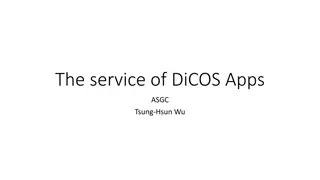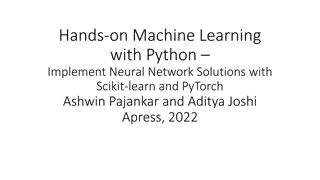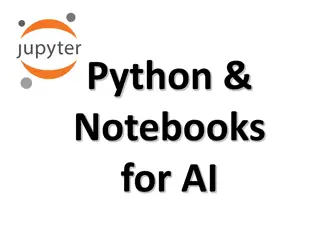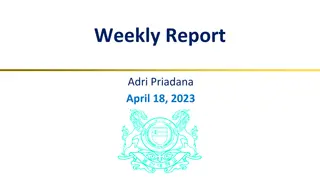USING GPUS IN DEEP LEARNING FRAMEWORKS
Delve into the world of deep learning with a focus on utilizing GPUs for enhanced performance. Explore topics like neural networks, TensorFlow, PyTorch, and distributed training. Learn how deep learning algorithms process data, optimize weights and biases, and predict outcomes through training loops
5 views • 98 slides
DiCOS Apps Overview and Data Management Guide
Discover the diverse range of DiCOS Apps available, from Bio-Apps like cryoSPARC and Relion to Phys-Apps such as Paraview and Ovito. Explore machine learning tools like PyTorch and Tensorflow, and learn about managing disk space for different user groups. Access examples on opening Jupyter with RTX
6 views • 11 slides
Hands-on Machine Learning with Python: Implement Neural Network Solutions
Explore machine learning concepts from Python basics to advanced neural network implementations using Scikit-learn and PyTorch. This comprehensive guide provides step-by-step explanations, code examples, and practical insights for beginners in the field. Covering topics such as data visualization, N
2 views • 13 slides
Python Notebooks for AI: Rapid Development and Exploration
Python has become the most popular programming language for AI due to its ease of use, large library of modules, and efficiency in rapid development. With new neural network packages like TensorFlow and PyTorch, Python is ideal for exploring and evaluating new AI ideas quickly using tools like Jupyt
0 views • 6 slides
Learning-Based Low-Rank Approximations and Linear Sketches
Exploring learning-based low-rank approximations and linear sketches in matrices, including techniques like dimensionality reduction, regression, and streaming algorithms. Discusses the use of random matrices, sparse matrices, and the concept of low-rank approximation through singular value decompos
0 views • 13 slides
Weekly Activities and Research Updates in Machine Learning - April 18, 2023
Adri Priadana's weekly report details recent activities like courses on machine learning, doctoral thesis research, and face recognition experiments using PyTorch. Updates on FasterNet Block, Split-based Inception Block, ResNet architecture modifications for improved face recognition accuracy are in
0 views • 10 slides
Vertex-Centric Programming for Graph Neural Networks
Seastar presents a vertex-centric programming approach for Graph Neural Networks, showcasing better performance in graph analytic tasks compared to traditional methods. The research introduces the SEAStar computation pattern and discusses GNN programming abstractions, execution, and limitations. Dee
0 views • 17 slides






